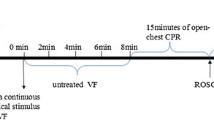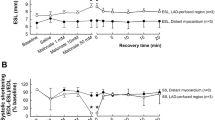Abstract
Amrinone, a phosphodiesterase inhibitor, is a non-glycosidic noncatecholamine with both vasodilator and positive inotropic effects. We were interested in assessing the effect of amrinone on postischemic cardiac performance in the isolated heart-lung preparation. Twenty-four male Wistar-ST rats were used. They were randomly divided into three groups. Amrinone, 10 μg·ml−1 or 100 μg·ml−1 was administered 8 min after the start of perfusion except in the control group. Ten minutes after the start of perfusion, all hearts were made globally ischemic for 8 min. Subsequently, the preparations were reperfused for 10 min. At the end of the experimental period, the hearts were freeze-clamped, and then myocardial high-energy phosphates, lactate, pyruvate, and glycogen were measured. Hemodynamic parameters in all groups decreased significantly during ischemia. However, there were no significant differences among the groups. The myocardial ATP level in the 100 μg·ml−1 group was significantly higher than that in the control group. Adenosine diphosphate (ADP) and adenosine monophosphate (AMP) levels in the 100 μg·ml−1 group were significantly lower than those in the control group. Myocardial lactate, pyruvate, and glycogen levels were not significantly different among the groups. This result suggests that amrinone improves postischemic myocardial metabolism. Although we could not measure coronary flow, amrinone might increase coronary flow with direct coronary vasodilation which would have increased the myocardial ATP and energy charge levels.
Similar content being viewed by others
References
Bailey JM, Levy JH, Rogers G, Szlam F, Hug Jr CC (1991) Pharmacokinetics of amrinone during cardiac surgery. Anesthesiology 75:961–968
Royster RL, Butterworth JF, Prielipp RC, Zaloga GP, Lawless SG, Spray BJ, Kon ND, Wallenhaupt SL, Cordell AR (1993) Combined inotropic effects of amrinone and epinephrine after cardiopulmonary bypass in humans. Anesth Analg 77:662–672
Lathi KG (1992) Amrinone in patients undergoing cardiac surgery. Anesthesiology 77:215
Butterworth JF, Royster RL, Robertie PG, Zaloga GP, Prielipp RC, Dudas LM (1990) Hemodynamic effects of amrinone in patients recovering from aortocoronary bypass surgery. Anesth Analg 70:S45 (abstract)
Kashimoto S, Tsuji Y, Kumazawa T (1987) Effects of halothane and enflurane on myocardium during postischemic reperfusion in the rat. Acta Anesth Scand 31:44–47
Kashimoto S, Nakamura T, Nonaka A, Kume M, Oguchi T, Kumazawa T (1994) Effects of artificial blood (FC-43 emulsion) on myocardial energy metabolism in the rat heart-lung preparation. Br J Anaesth 73:380–383
Nonaka A, Kashimoto T, Nakamura T, Kumazawa T (1994) Effects of intravenous anaesthetics on function and metabolism in the isolated rat heart-lung preparation. Eur J Anaesth 11:213–219
Wynants J, Belle HV (1985) Single-run high-performance liquid chromatography of nucleotides, nucleosides, and major purine bases and its application to different tissue extracts. Analyt Biochem 144:258–266
Bergmeyer HU (1975) Neue Werte für die molaren Extinktions-Koeffizienten von NADPH zum Gebrauch im Routine-Laboratorium. Z Klin Chem Klin Biochem 13:507–508
Werner W, Rey H-G, Wielinger H (1970) Über die Eigenschaften eines neuen Chromogens für die Blutzuckerbestimmung nach der GOD/POD Methods. Z Analyt Chem 252:224–228
Cambell CA, Mehta PM, Wynne J, Kloner A (1987) The cardiotonic agent amrinone does not increase anatomic infarct size. J Cardiovasc Pharmacol 9:225–229
Rump AF, Blazincic B, Klaus W (1993) Effects of amrinone and milrinone on myocardial ischemia extent and infarct size in isolated rabbit hearts. Arzneimitt elforschung 43:1262–1266
Fujigaki T, Nakamura H, Fukui S, Haseba S, Gotoh Y (1989) Comparison of the effects of amrinone and dobutamine on hemodynamics and myocardial oxygen balance in dogs with experimental left ventricular failure. J Cardiothorac Anesth 3:433–440
Kirk ES, LeJemtel TH, Nelson GR, Sonneblick EH (1978) Mechanisms of beneficial effects of vasodilators and inotropic stimulation in the experimental failing ischemic heart. Am J Med 65:189–96
Jentzer JH, LeJemtel TH, Sonnenblick EH, Kirk ES (1981) Beneficial effect of amrinone on myocardial oxygen consumption during acute left ventricular failure in dogs. Am J Cardiol 48:75–83
Rooney RT, Stowe DF, Marijic J, Bosnjak ZJ, Kampine JP (1991) Amrinone reverses cardiac depression and augments coronary vasodilation with isoflurane in the isolated heart. Anesthesiology 74:559–567
Takeda K, Matsui K, Nakazawa H, Nakahara H, Imai H, Imai S (1986) Cardiotonic and coronary vasodilatory effects of amrinone in the canine heart-lung preparation with a support dog as compared with those of dobutamine. Jpn J Pharmacol 40:381–388
Drexler H, Hoing S, Faude F, Wollschlager H, Just H (1987) Central and regional vascular hemodynamics following intravenous milrinone in the conscious rat: comparison with dobutamine. J Cardiovasc Pharmacol 9:563–569
Sidi A, Pool JM, Rush W (1993) Early administration of amrinone dose not impair regional metabolism of O2 or lactate and, by improving myocardial performance, preserves myocardial blood flow in the ischemic canine heart. Anesth Analg 76:1201–1212
Zucchi R, Poddighe R, Mariani M, Ronca G (1990) Effect of amrinone in the working rat heart: influence of ischemic damage, adenosine and calcium. Drugs Exp Clin Res 16:187–195
Onuaguluchi G, Tanz RD (1981) Cardiac effects amrinone on rabbit papillary muscle and guinea pig Langendorff heart preparations. J Cardiovasc Pharmacol 3:1342–1355
Rude RT, Kloner RA, Maroko PR, Khuri S, Karaffa S, DeBoer LWV, Braunwald E (1980) Effects of amrinone on experimental acute myocardial ischaemic injury. Cardiovasc Res 14:419–427
Zannad F, Juillere Y, Royer RJ (1983) The effects of amrinone on cardiac function, oxygen consumption and lactate production of an isolated, perfused, working guinea-pig heart. Arch Internat Pharmacodyn Ther 263:264–271
Author information
Authors and Affiliations
About this article
Cite this article
Kume, M., Kashimoto, S., Furuya, A. et al. Amrinone improves postischemic myocardial metabolism in the rat heart-lung preparation. J Anesth 10, 269–275 (1996). https://doi.org/10.1007/BF02483394
Received:
Accepted:
Issue Date:
DOI: https://doi.org/10.1007/BF02483394




